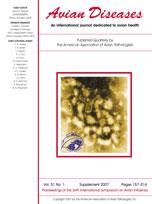Ducks and other wild aquatic birds are the natural reservoir of type A influenza viruses, which normally are nonpathogenic in these birds. However, the Asian highly pathogenic avian influenza (HPAI) viruses have evolved from producing no disease or mild respiratory infections in ducks to some strains producing severe systemic disease and mortality. To further understand the pathogenicity of these strains in ducks, we studied the gross and histologic lesions and tissue distribution of viral antigen in 2- and 5-wk-old white Pekin ducks infected with different Asian-origin H5N1 AI viruses. Seven of eight 2-wk-old ducks inoculated with A/Egret/HK/757.2/02 developed acute disease, including severe neurological dysfunction and death. However, this virus killed only two of eight 5-wk-old ducks. Two additional viruses, A/Vietnam/1203/04 and A/Crow/Thailand/04, also produced high mortality in 2-wk-old ducks. Microscopic lesions and AI viral antigen were observed most frequently in the nasal cavity, brain, heart, adrenal glands, and pancreas. Another virus, A/Thailand PB/6231/04, killed three of eight 2-wk-old ducks but did not induce neurological signs. Furthermore, older ducks infected with this virus did not present clinical signs or gross lesions, and their tissues showed very few microscopic lesions. All the viruses studied established systemic infections in both younger and older ducks, with viral replication in tissues correlating with the severity of the clinical signs. The differences in mortality induced by HPAI H5N1 viruses in ducks are reflected in the pathological findings and antigen distribution in tissues. However, the observed differences in pathology between ducks infected at different ages is unclear and may be associated with a variety of factors including the virus strain, host immune response, host cell maturation, and capacity to support viral replication.
How to translate text using browser tools
1 March 2007
Pathobiology of Asian Highly Pathogenic Avian Influenza H5N1 Virus Infections in Ducks
Mary J. Pantin-Jackwood,
David E. Swayne
ACCESS THE FULL ARTICLE

Avian Diseases
Vol. 51 • No. s1
March 2007
Vol. 51 • No. s1
March 2007
avian influenza
ducks
H5N1 virus
immunohistochemistry
pathogenicity




